AMD’s 5 GHz Turbo CPU in Retail: The FX-9590 and ASRock 990FX Extreme9 Review
by Ian Cutress on August 9, 2014 8:00 AM ESTGaming Benchmarks
F1 2013
First up is F1 2013 by Codemasters. I am a big Formula 1 fan in my spare time, and nothing makes me happier than carving up the field in a Caterham, waving to the Red Bulls as I drive by (because I play on easy and take shortcuts). F1 2013 uses the EGO Engine, and like other Codemasters games ends up being very playable on old hardware quite easily. In order to beef up the benchmark a bit, we devised the following scenario for the benchmark mode: one lap of Spa-Francorchamps in the heavy wet, the benchmark follows Jenson Button in the McLaren who starts on the grid in 22nd place, with the field made up of 11 Williams cars, 5 Marussia and 5 Caterham in that order. This puts emphasis on the CPU to handle the AI in the wet, and allows for a good amount of overtaking during the automated benchmark. We test at 1920x1080 on Ultra graphical settings.
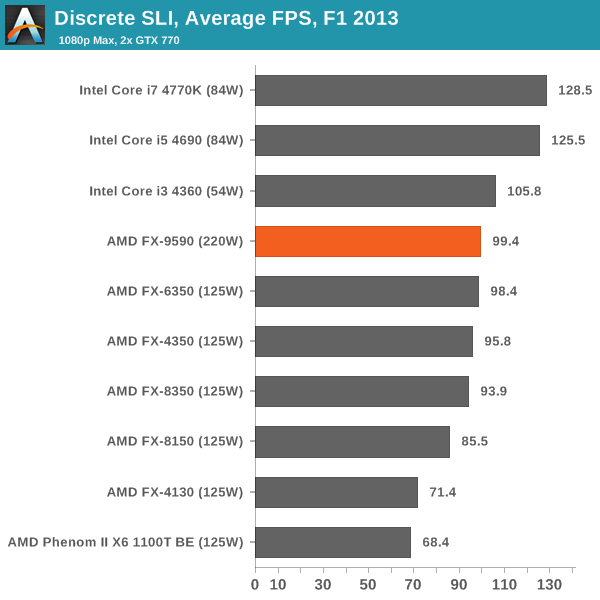
The FX-9590 seems to match the i3-4360, indicating that even more cores, more frequency and more PCIe lanes is not always a good thing. The i3-4360 is using PCIe 3.0 x8/x8, compared to PCIe 2.0 x16/x16 for the FX-9590, which should put them both equal in bandwidth.
Bioshock Infinite
Bioshock Infinite was Zero Punctuation’s Game of the Year for 2013, uses the Unreal Engine 3, and is designed to scale with both cores and graphical prowess. We test the benchmark using the Adrenaline benchmark tool and the Xtreme (1920x1080, Maximum) performance setting, noting down the average frame rates and the minimum frame rates.
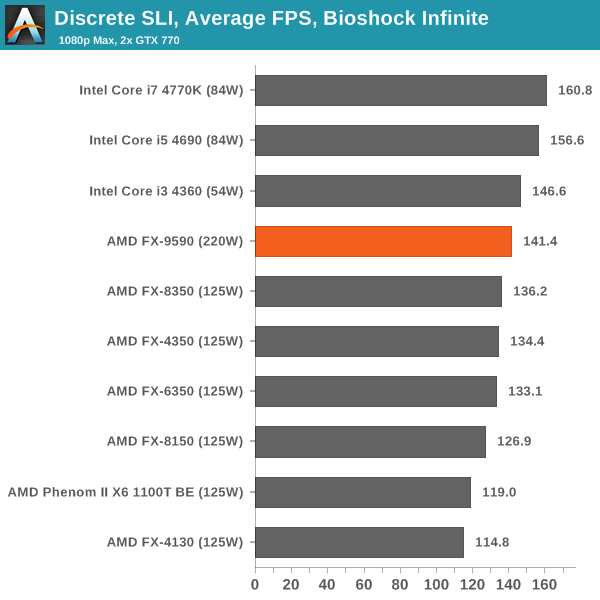
Again, the FX-9590 is trading around the Haswell i3 margin.
Tomb Raider
The next benchmark in our test is Tomb Raider. Tomb Raider is an AMD optimized game, lauded for its use of TressFX creating dynamic hair to increase the immersion in game. Tomb Raider uses a modified version of the Crystal Engine, and enjoys raw horsepower. We test the benchmark using the Adrenaline benchmark tool and the Xtreme (1920x1080, Maximum) performance setting, noting down the average frame rates and the minimum frame rates.
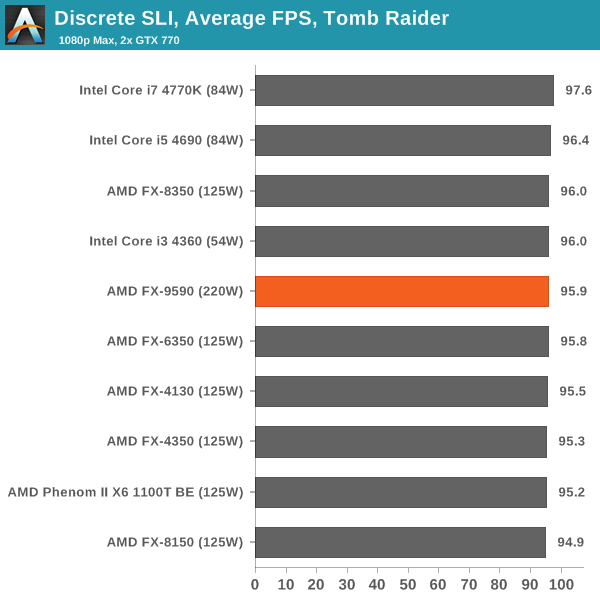
Tomb Raider has historically been CPU agnostic, with all the latest CPUs performing similarly.
Sleeping Dogs
Sleeping Dogs is a benchmarking wet dream – a highly complex benchmark that can bring the toughest setup and high resolutions down into single figures. Having an extreme SSAO setting can do that, but at the right settings Sleeping Dogs is highly playable and enjoyable. We run the basic benchmark program laid out in the Adrenaline benchmark tool, and the Xtreme (1920x1080, Maximum) performance setting, noting down the average frame rates and the minimum frame rates.
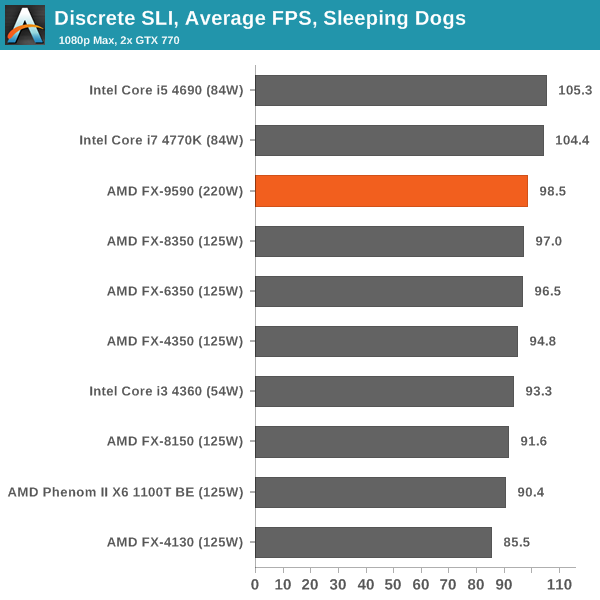
The FX-9590 loses 4-6 FPS on average to the latest Intel cohort, which is not bad considering the release date difference.
Company of Heroes 2
Company of Heroes 2 also can bring a top end GPU to its knees, even at very basic benchmark settings. To get an average 30 FPS using a normal GPU is a challenge, let alone a minimum frame rate of 30 FPS. For this benchmark I use modified versions of Ryan’s batch files at 1920x1080 on High. COH2 is a little odd in that it does not scale with more GPUs with the drivers we use.
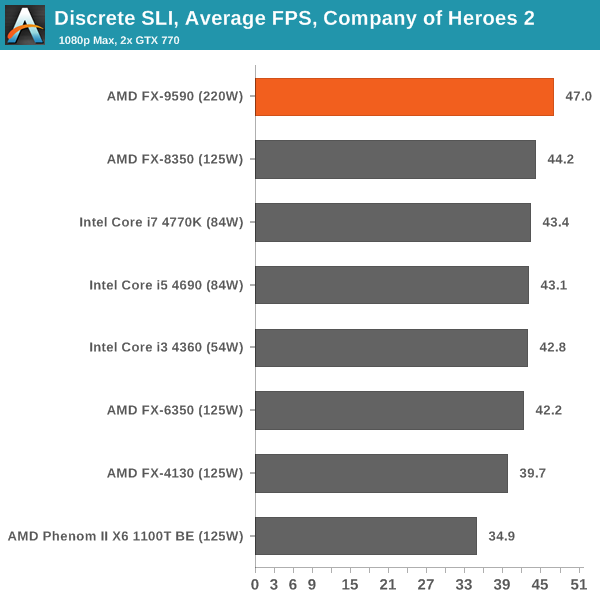
Company of Heroes 2 is usually relatively CPU agnostic except for the older dual core CPUs, but the FX-9590 gets a win here.
Battlefield 4
The EA/DICE series that has taken countless hours of my life away is back for another iteration, using the Frostbite 3 engine. AMD is also piling its resources into BF4 with the new Mantle API for developers, designed to cut the time required for the CPU to dispatch commands to the graphical sub-system. For our test we use the in-game benchmarking tools and record the frame time for the first ~70 seconds of the Tashgar single player mission, which is an on-rails generation of and rendering of objects and textures. We test at 1920x1080 at Ultra settings.
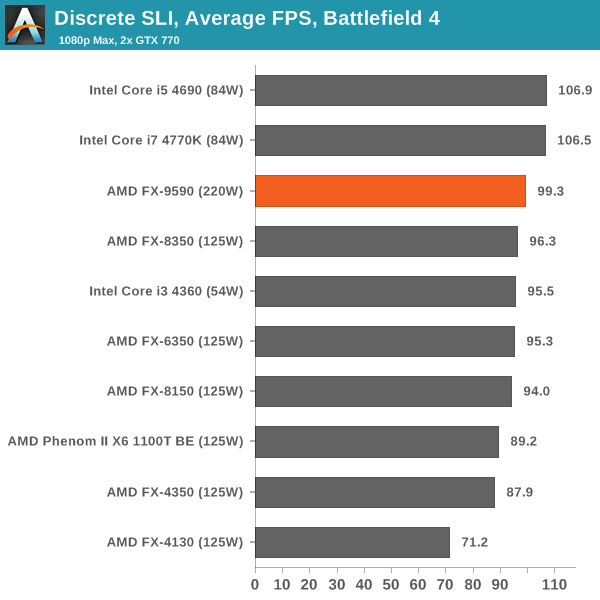
Similar to Sleeping Dogs, the FX-9590 does not lose much considering the release date difference of the architectures.






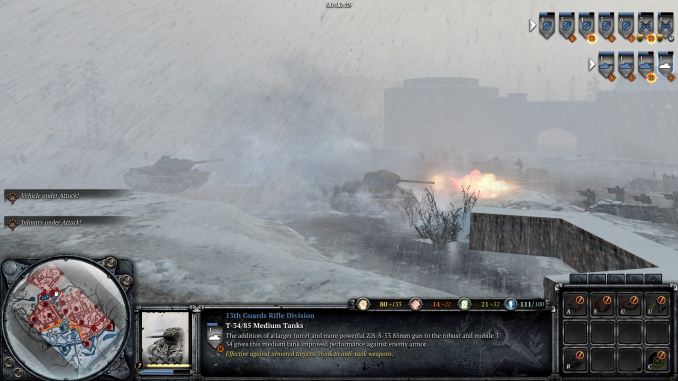









146 Comments
View All Comments
wurizen - Saturday, August 9, 2014 - link
the fx series does need to go down in watts, which only comes in a die shrink from what i know. but the thing it has going for it are 8 cores, which intel doesn't even have in their consumer or enthusiast cpu's. u have to go xeon to find an intel 8 core cpu. my theory that amd is not updating the fx series or their chipsets is probably due to the backlash of the of fx series. i forgot when the the fx-8150 came out but it was negative. i don't think amd wants to have another repeat of that so amd is putting their cards back in the deck. they're softly announcing this and that about apu's... and hoping the marketing of apu will be enough to garner positive feedback. bring the image back. that is all it is, i think. what the hell is an apu, anyway? oh, it's the future. this is what amd wants ppl to know. but, we know that apu is not the future. it's just a stop gap for amd. it's just a fancy acronym.i don't think the low performance of amd fx cpu compared to an intel part is also solely amd's fault. i think software developers/coding can also be attributed to it. i mean, if you have this and that code built for intel chips since they're inside (i hate to say it) most of the pc's in the world, then of course, intel will have a lead from the get go. for example, windows 8 is suppose to be better for amd fx cpu's than windows 7. now dig deeper into how programs are run and make it so that an fx chip will shine as much as an intel chip, then we probably have a very well optimized program, which in the real world is probably a unicorn program. so, this unicorn program puts both amd and intel chips thru its paces, equally and optimally and fully. and i think that unless an intel chip has a specific function that makes it run faster (i forgot what it is), then an amd fx 8-core chip with its more logical, fully functional, real cores of 8 will probably be better than intels 4 cores with hyperhtreading. intel has patents for those specific, specialize tasks though and this is why intel is hard to beat and why amd loses to them.
this is why amd is waiting b/c 1)amd knows intel's roadmap and 2)they have apu's and consoles as stop gap 3) they'll return to the desktop performance cpu when the tide, the program/software/patents or whatever it is has leveled out so that amd can put out a competitive product that is truly innovative. and not just tick and tocks 4) the cpu fabs are probably too expensive right now for amd to jump in and do a die shrink (not sure tho; maybe intel has a hand in that too? idk)--like why is intel the only cpu company doing die shrinks every year and half? sounds weird to me. and it's closest competitor is just sitting back. weird right? anyway, im out of theories, i think.
oh, you'd think amd would just put 8 core kaveris without an igpu, right? but, no. i think amd is still not sure the performance gain with that will be enough to wipe out the negativity of the fx-8150 debacle. so, amd is just not doing it.
what do you guys think of my theories?
Death666Angel - Sunday, August 10, 2014 - link
"but the thing it has going for it are 8 cores, which intel doesn't even have in their consumer or enthusiast cpu's."I stopped reading right there. If you think 8 cores in a 4 module FX CPU are comparable to 4 cores in Intel mainstream CPUs or 8 cores in Intel enthusiast CPUs, you should go back and read up on the architecture differences. The fact that an Intel 8 thread CPU (core i7 with 4 cores and HT) usually beats any FX CPU with 4 modules should be warning enough that you shouldn't draw any conclusions based on that.
wurizen - Sunday, August 10, 2014 - link
Ive read up on bulldozer architecture. 4 modules with 2 logical and physical cores = 8 cores. Intels hyperthreading arent physical cores but software driven. so an OS sees an i7 with 8 cores even tho 4 of those cores are virtual. AMD has 8 physical/logical cores. Each module or 2 cores do have to share FpU, l2 cache (i think) and another thing. So, the cores are hampered by this but it doesnt take away the fact that there are 8 cores there. And i know its slow even though it has more cores than intel. But by refining it and better software optimization, i am wishing AMD to at least compete with intel enthusiast x99 chipset in the future with half the price. Why? Bc i cant afford intel. Simple as that.mapesdhs - Tuesday, August 12, 2014 - link
Sorry it's not an 8-core at all, not when it has to share resources split int vs. fp. Hence whythis very article shows again and again the older 4770K beating the 959 on threaded loads,
with 60% less power consumption. Convincing yourself that AMD's "8 cores" marketing has
any kind of sensible basis is as bad as believing MHz is an equally useful metric, or MIPS.
Intel's real, old, 6-core, the 3930K, utterly demolishes the 9590, for less power, etc. If you're
on a budget, buy a used 3930K, it'll leave AMD's chips in the dust, and there are plenty of
low cost X79 boards these days, especially on the used market (Gigabyte UD3 only cost me
55 UKP).
Ian.
Budburnicus - Wednesday, January 14, 2015 - link
Noob, 2x ALU per unit DOES NOT equal 2 FULL CPU cores! The ONLY "edge" AMD has gained by this, frankly, AWFUL architecture, is in marketing, because they can somehow LEGALLY call each unit 2 CPU cores - when they do not function as such at all! In fact, HyperThreading provides better real world performance that doubling APU's when the architecture involved has much higher IPC as well as a DEDICATED minimum of 168 GB/s to L3 cache per core, at stock speeds!AMD calling a 4 unit CPU an 8 core machine is essentially the same as intel calling a 4 core i7 an 8 core CPU! HyperThreading is NOT software! read more about CPUs bro.
Budburnicus - Wednesday, January 14, 2015 - link
*than doubling ALUs*Budburnicus - Wednesday, January 14, 2015 - link
EXACTLY! +1Laststop311 - Monday, August 11, 2014 - link
you said intel has no non xeon 8 core cpu's. But haswell-e will have 8 core/16 thread. I currently run an i7-980x gulftown x58 system and will be replacing it with 8 core haswell-e. video production speed should sky rocket.mapesdhs - Tuesday, August 12, 2014 - link
That depends on what you're doing, which app, where the bottlenecks reside, etc.If you've already oc'd your 980X then you're starting from a pretty good baseline,
so don't expect HW-E to be that much better (NB: I have a 990X, a couple of 3930Ks,
4820K, seveal 2700Ks, etc.)
What really will help for you is the newer I/O provision, ie. SATA3, PCI Express, M.2, etc.
The non-Intel SATA3 controllers on X58 boards were pretty awful, especially Marvell.
And of course you can at least double your max RAM, which might be holding you back
somewhat if you're a heavy AE user.
Ian.
Arbie - Sunday, August 10, 2014 - link
I think 'ur' Shift key is broken.